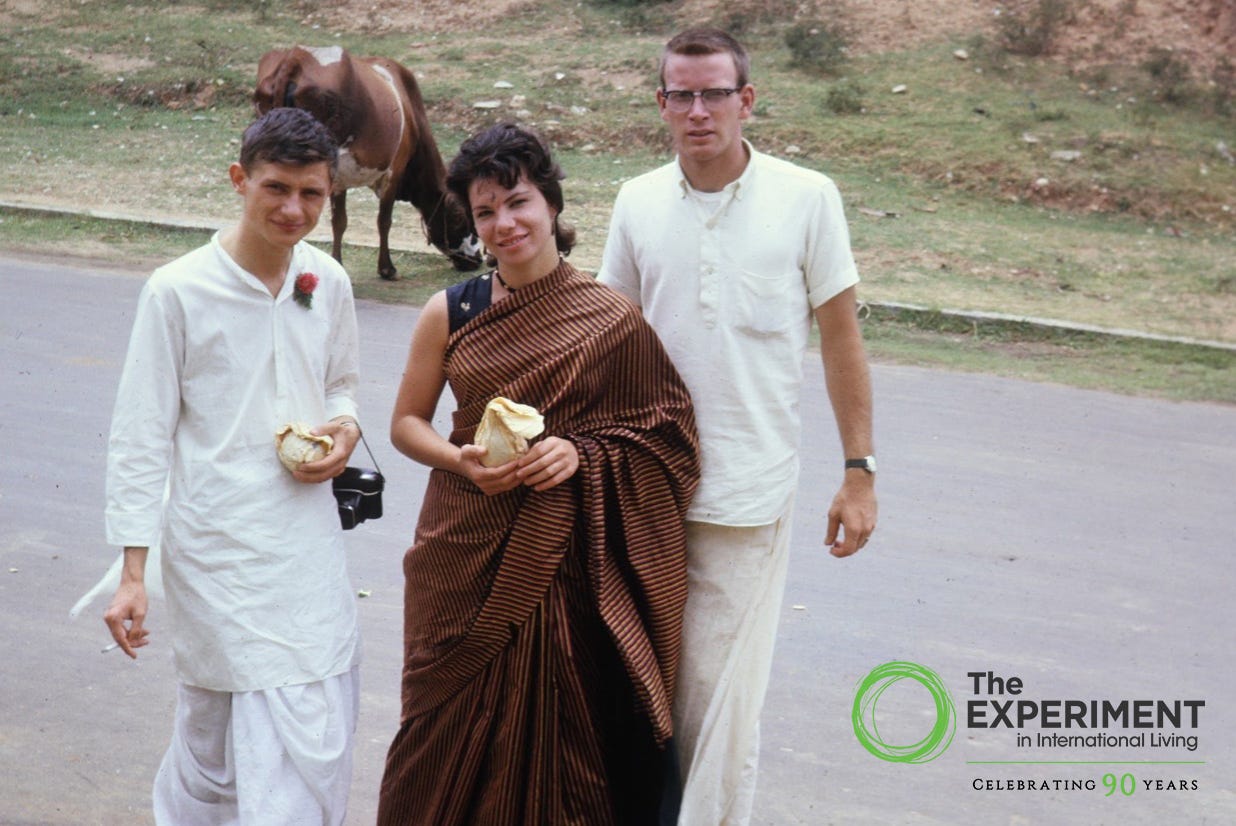World Learning is celebrating its 90th anniversary this year, and it all started with The Experiment in International Living. The Experiment has been at the cutting edge of intercultural exchange since its founding in 1932, allowing students from around the world to experience the world as a classroom. Take it from a group of Experimenters who traveled to India 60 years ago, and to this day, remember the adventures and lessons they learned during their life-changing journey.

It all began the summer of 1962 in Brattleboro, Vermont. Ten college students — complete strangers — met for a true experiment in international living: a cross-cultural trip to India. This life-changing experience enriched their outlook and influenced their lives in ways never to be forgotten. Sixty years later, five of these students — Francie Yates Handler, Linda Russack Tobin, Jon Darrah, Dr. James Meadowcroft, and Dr. Anthony “Tony” Elite (who served as the leader) — reminisce about their trip with The Experiment.
From the start of their orientation, The Experiment eased them into the beautiful and complex cultures of India. They read, discussed, and tasted everything to do with Indian life. They also had an introduction to the basics of Hindi, Urdu, and Kanarese (Kannada).

Air India 707
The students then excitedly boarded a 707 Air India plane, which at the time was a novelty. After stops in London, Istanbul, and Beirut, they landed 24 hours later, bleary-eyed, in Bombay at five in the morning. As they arrived at their hotel, they were greeted by a welcoming group of hosts who hung fragrant flowers around their necks.
Tobin remembers her host sister, Smita Shah, like a vision in a crisp pink sari. They took an instant bonding to each other.
After touching down in India, they spent their first days exploring Bombay on foot. They basked in the aroma of the mélange of incense, spices, bonfires, and flowers. They took in the sights and sounds of Hindi temples, cows, bullock carts, and car horns at every twist and turn. They attended a special private concert in Bombay’s Malabar district apartment with composer Ravi Shankar, which they describe as a “mind-blowing experience.”
Following Bombay, their experiment took them to the Bandipur National Park, where they waded through grassy slopes featuring cape buffalo, cheetah, and tiger territories. They learned about the animals’ natural habitats — and the need to respect its boundaries when a mother elephant charged their way to protect her calf. Just as the students saw the elephant, they were rescued to safety by their quick-thinking park ranger.
While the Experiment is known for its curated intercultural exchanges, students can often step off the beaten path to fully enrich themselves in the communities around them. Handler and Tobin remember taking a ferry from Cochin to a small Jewish community to learn about its long and diverse history.

Bombay, India
Their journey included sightseeing trips to Delhi and North Delhi, and a trip to Agra to see the majesty of the Taj Mahal that they remember as a “monument of extraordinary beauty.” They took advantage of the Calcutta Mail, a Trans-Indian train with many stops that allowed them to pick and choose different locales to explore, such as Calcutta and the Ajanta and Ellora Caves, now UNESCO world heritage sites. They also visited the Hindu temples of Belur and Halebidu, the Nandi Bull, and the Jain temple of Shravanabelagola.
In 60 years, India has changed, we have changed, but the fact remains, our experiences of those two months continue to shape our lives every day.
The group remembers long discussions on a wide range of topics: philosophy, religion, social services, classical Indian dance, celebrations, music, meditation, and gardening. They recall learning about sericulture (silk production), south Indian dance, and Ayurvedic medicine, the ancient Indian medical system that emphasizes a holistic approach to health.
They also remember eating a variety of Indian food, learning to cook, and adapting to new dining habits. Meadowcroft recalls eating meals in a separate room of his home as his host grandmother thought his shadow would contaminate the food and cooking utensils. Tobin was awakened on her first morning with a sweet, hot milk tea before she was even out of bed.
“Each of us has funny stories of our encounters with spicy food, chewing betel nuts, runny noses, and eating with our hands — ‘right only!’ we were taught,” said Elite.

The group at The Experiment’s Sandanona campus.
Back home, several of the Experimenters took what they learned about cultural immersion and intercultural exchange into careers. Elite consulted on cross-cultural psychiatric assignments with the Peace Corps, East African Child Development program, and Indian Health Services. Darrah was a country director for the Peace Corps. And Tobin did several projects with nongovernmental organizations in Bombay and Madurai.
Decades later, these Experimenters still fondly remember the formative journeys they experienced, the deep bonds they created, and the host families who made them feel so welcome. What became the most lasting and humbling experience was living with their host families. Sixty years later, each of the group is still in touch with their families and have hosted them in the United States through the years.
“In 60 years, India has changed, we have changed, but the fact remains, our experiences of those two months continue to shape our lives every day,” Elite said.
“We gained an affirmative grounding of our core universal humanity. We each understand our roles as citizens of the world in a way we never could have without these palpable experiences. For this experience that changed our lives, our gratitude is unending.”
With fondest memories of the others who shared this journey with us:
Edwin “Eddie“ Griffiths, Ron Barton, Arline Kaplan, Elizabeth “Betsy“ Lane, and Richard “Dick“ Shira.


